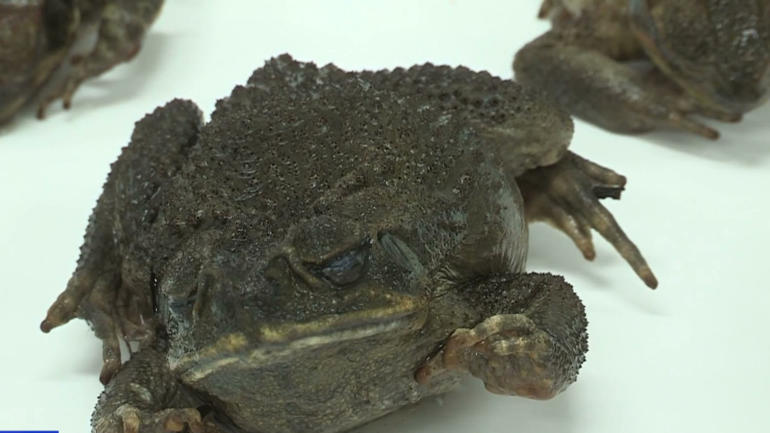Eighty years ago, cane toads were first introduced in Australia to manage a crop beetle. Now, millions of the poisonous amphibians are posing a huge environmental and ecological threat. CGTN’s Greg Navarro reports.
The styrofoam container inside a Brisbane lab is filled with frozen cane toads. sent to scientists who are working on a way to get rid of them.
A toxin from the toads is extracted, then blended and dripped onto bait. It is used to draw cane toad tadpoles into a container, where they are captured and killed.
“We think that taking out hundreds of thousands or even millions of poisonous tadpoles is an end in itself because those were poisonous tadpoles that had the capacity to poison aquatic life, they are taken out,” said Professor Rob Capo at the Institute for Molecular Bioscience at the University of Queensland.
But the groundbreaking process, developed at the University of Queensland, relies on the public to catch adult cane toads and send them to the lab.
Female cane toads can produce up to 40,000 eggs at a time, and there are millions of the poisonous amphibians across the country.
Cane toads were introduced to Australia from South America eight decades ago to eat sugar cane beetles that threatened the Queensland crop.
The problem with that initial failed experiment is that nobody really thought through the fact that cane toads are not prolific jumpers and didn’t have the ability to reach those beetles on the sugar cane, the very beetles they were brought into eradicate
Instead, the toad population exploded. Each one equipped with a toxin that is used to deter hungry predators.
“There are no native toads in Australia so our native predators can’t deal with that poison so we get massive mortality, 90% and 95%, these big predators are killed within a few months of the toads arriving so it is a catastrophe,” Macquarie University biologist Professor Rick Shine said.
The amphibious invader has also become cultural icon, featured in movies and TV ads.
Over the years, finding creative ways to get rid of cane toads has become something of a sport.
“There was something about the toad being an alien and not belonging here that really seemed to reinforce this remarkably strong hatred,” Shine said.
Some native animals have learned not to eat the poisonous toads, and their numbers have rebound over time.
“Imagine what the wildlife looked like before the toads got here and caused the chaos that they have done,” Capon said.
Some politicians have proposed cash for cane toads schemes to help reduce the population.
And while the science used here is impressive, Capon says it is not going to eradicate cane toads.
There still is nothing stopping these creatures from creating chaos as they continue to move across the country.
 CGTN America
CGTN America

